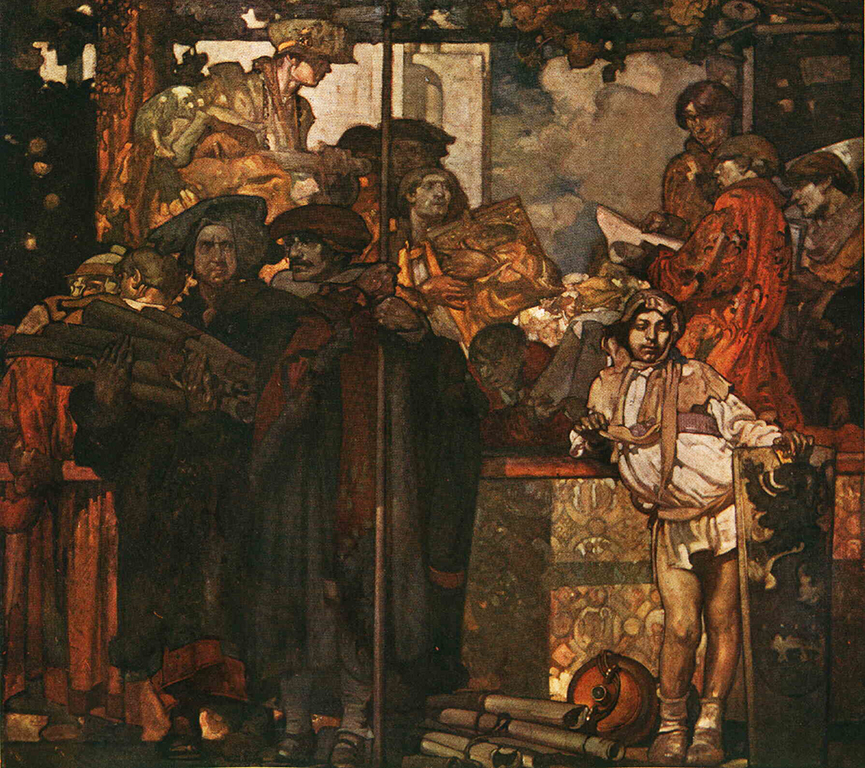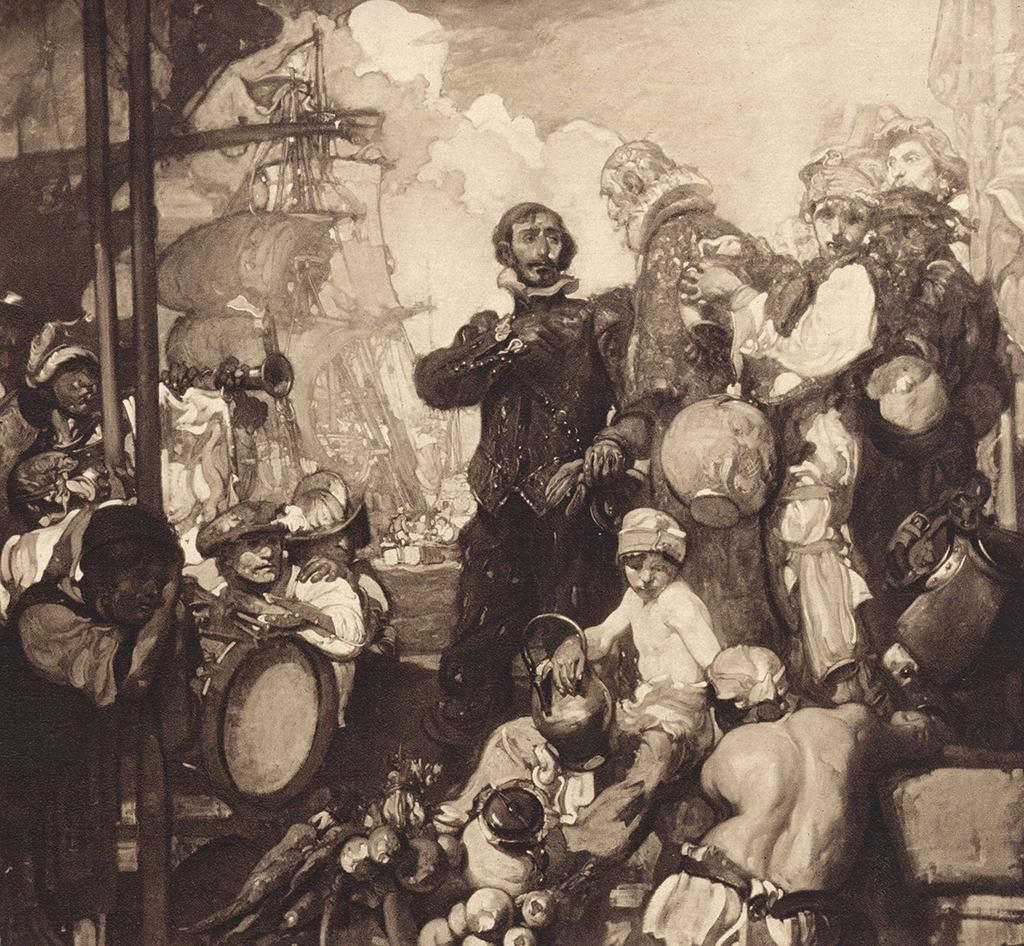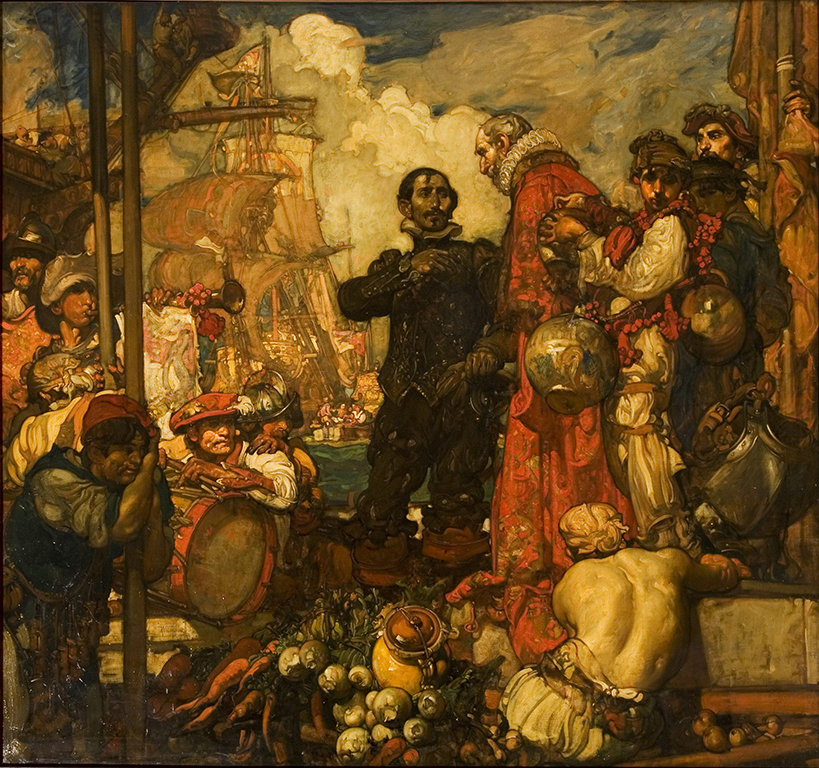
The first series of panels were painted 1902-1909. Panels 1, V, X and XIV measure 289.6×152.4cm (9ft6inx5ft3in), the remainder measure 289.6x320cm (9ft6inx10ft6in)
I Pelts and Furs at City Mart before the Charter
II Edward III granting the Charter on 1 March 1327 (illustrated above)
III River Procession of City’s and Company’s Barges to Westminster, 1453
IV Strife between Skinners and Merchant Taylors, 1483
V Sir A Judd’s Founding of Tonbridge School 1553
X An Incident in Sir A Judd’s Defence of London, 1554
XI City Pageant in Olden Times
XII Departure of Sir James Lancaster for East Indies, 1594 (1st panel to be put in place. Exhibited at the RA, the year Brangwyn was elected as an Associate).
XIII Reception of General Monk at Skinners’ Hall, 4th April 1660
XIV Lord Mayor Pilkington entertaining King and Queen, 1689
Brangwyn originally painted Fruits of Industry (M4690) (now in Mildura Art Gallery, Australia), oil on canvas 152.5 x 365 cm (60×143.7in), signed and dated 1909 for the Gallery which his assistant Bradshaw considered a different style from later work. This was however replaced by Harmony, panel XV.
Four further panels were installed in 1937, wrapping round the corner at the window end of the hall. Panels VI and VII are titled Charity and panels VIII and IX are titled Education. Ditchling villagers, including Sir Donald Sinden when a young boy, and the assistant Kenneth Center were used as models for these panels. The panels are same size as the smaller of the first set.
The Departure of Lancaster was hailed by The Studio critic as ‘a magnificent performance – sumptuous in colour and vigorous in design’. The panel depicts Lancaster, a pioneer of English Trade with the East Indies, about to set sail from Deptford near the house of fellow Skinner, Sir Thomas Smythe. A youth lounges languidly in the foreground, nestling a large pot, chatting to his friend. However the youth did not appear in a compositional sketch for the panel but was included in an oil study. And he is not in the panel currently on display – he would have been somewhere under Smythe’s flowing red robes. Interestingly enough, in 1909 Brangwyn asked permission to ‘repaint his first picture … as it is too deep in colour and could not be harmonised with the others as he would like it to be’. The artist offered to make a new panel for a mere £50, leaving the original with the Company, and it was recommended that this course of action be taken. However the Company are not aware of a second version of the painting. It might be that the original panel was overpainted and a colleague kindly clambered up some scaffolding a couple of years back with a laser lamp and thought he possibly detected images of the boy under the cloak. However there are some other minor differences between the panel hanging there and the one exhibited at the Royal Academy. But Brangwyn would never have painted 2 almost identical panels – he had far too imaginative for that. So a conundrum and a mystery waiting to be resolved!


Departure of Lancaster 1st and 2nd versions.
Literature: West, ‘The Exhibition of the Royal Academy, 1904’, The Studio, Vol 32, p26. The Builder, p656 XCVIII, 11 June 1910. Furst, 1924 p66-80. Rodney Brangwyn, Brangwyn, William Kimber London 1978 p93-99. Macer-Wright, Brangwyn, A Study of Genius at Close Quarters, Hutchinson & Co London p76-77. Shaw-Sparrow, Frank Brangwyn and his Work, Kegan Paul, Trench, Trubner & Co Ltd London 1915 p149-161. W H Draper, The Historical Paintings in the Skinners Hall, Caradoc Press London 1909. Galloway, 1962 p71. Clare Willsdon, Mural painting in Britain 1840-1940, Oxford University Press 2000 p82-93. Alford/Horner, Brangwyn in his Studio, Roger Alford Guildford 2004 p20n44. Skinners’ Company Annual Report, 2006 p28,29, Horner, ‘Brangwyn’s Panels in the Banqueting Hall – A Brief History’. Art Journal, 1904, ‘Passing Events’, p171 – states that No 3 already in place in Skinners when Lancaster shown at RA, so this was probably second panel in place. Horner/Naylor, 2006, Powers, ‘The murals of Frank Brangwyn’.
Illustrated: Thirties Exhibition Catalogue, 1936 p124 Education panel . Galloway, 1962 plate 34, panel 8. Furst, 1924 panel 2 (facing p 75); panel 4 (p69); panel 6 (p79); panel 7 (p77); panel 9 (p72). The Elliott Collection, Mildura Arts Centre, 1998, p18 Fruits of Industry. Shaw-Sparrow,Frank Brangwyn and his Work, Kegan Paul, Trench, Trubner & Co Ltd London 1915, Fruits of Industry (facing p144); panel 3 (frontispiece); panel 9 (facing p152). Warwick H Draper, Historical Panels in the Hall of the Skinners Co, Caradoc Press London 1909, finished panels and studies. Brig.Gen. Sir Percy Sykes, The Story of Exploration and Adventure, George Newnes 1938, Lancaster on cover of part 1. The Studio, p28 Vol 32, June 1904, Lancaster (1st version). Rodney Brangwyn, Brangwyn, William Kimber London 1978 cover, Lancaster (2nd version). Shaw-Sparrow, The Spirit of the Age, London, 1905 plate 4. Art et Decoration, Leonce Benedite, ‘Brangwyn’, Vol XVII, 1st semester 1905, p23 Lancaster (2nd version). Colour Magazine, May 1915, p136/137, Fruits of Industry. Art et Decoration, Guillemot Maurice, ‘Brangwyn, Décorateur’, Vol XXVI, 2nd semester 1909, p104, Fruits of Industry, p108, River Procession. Craftsman The, Reuterdahl Henry, ‘Frank Brangwyn: Painter-Etcher’, XXIII, 4 January 1913, p388 (Lancaster, 1st version). Willsdon, Mural Painting in Britain 1840-1940, 2000, Plate X (Lancaster without boy), XI, XII, XIII, p72, 84, 85, 86, 92. Rutter, Modern Masterpieces, p147, Lancaster (2nd version). RA Pictures, 1904, part 3, p97, Lancaster. Art Journal, 1904, ‘Passing Events’, p173, titled A Music Party in the Time of Chaucer (No 3); p191 Lancaster. Skinners’ Company, Annual Report 2006, p28, Harmony. Horner/Naylor, 2006, Powers, ‘The murals of Frank Brangwyn’, p83, 89
See also Skinners study and Man presenting petition and Reception of General Monk and Two beggars